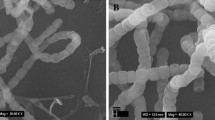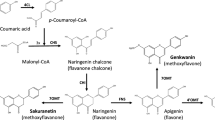Abstract
A marine Streptomyces sp. 060524 capable of hydrolyzing the glycosidic bond of isoflavone glycosides, was isolated by detecting its β-glucosidase activity. 5 isoflavone aglycones were isolated from culture filtrates in soybean meal glucose medium. They were identified as genistein (1), glycitein (2), daidzein (3), 3′,4′,5,7-tetrahydroxyisoflavone (4), and 3′,4′,7-trihydroxyisoflavone (5), based on UV, NMR and mass spectral analysis. The Streptomyces can selectively hydroxylate at the 3′-position in the daidzein and genistein to generate 3′-hydroxydaidzein and 3′-hydroxygenistein, respectively. The Strain biotransformed more than 90% of soybean isoflavone glycosides into their aglycones within 108 h. 3′-hydroxydaidzein and 3′-hydroxygenistein exhibited stronger cytotoxicity against K562 human chronic leukemia than daidzein and genistein.





Similar content being viewed by others
References
Adlercreutz H (1995) Phytoestrogens: epidemiology and a possible role in cancer protection. Environ Health Perspect 103:103–112. doi:10.2307/3432518
Arora A, Nair MG, Strasburg GM (1998) Antioxidant activities of isoflavones and their biological metabolites in a liposomal system. Arch Biochem Biophys 356:133–141. doi:10.1006/abbi.1998.0783
Bugni TS, Ireland CM (2004) Marine-derived fungi: a chemically and biologically diverse group of microorganisms. Nat Prod Rep 21:143–163. doi:10.1039/b301926h
Dong XZ, Xin YH, Jian WY et al (2000) Bifidobacterium Thermacidophilum sp.nov., isolated from an anaerobic digester. Int J Syst Evol Microbiol 50:119–125
Franke AA, Custer LJ, Cerna CM et al (1995) Rapid HPLC analysis of dietary phytoestrogens from legumes and from human urine. Proc Soc Exp Biol Med 208:18–26
Holland H, Weber HK (2000) Enzymatic hydroxylation reactions. Curr Opin Biotechnol 11:547–553. doi:10.1016/S0958-1669(00)00142-7
Hu C, Ding XL (1996) Antioxidant effect of flavonoid in different oxidation systems. Food Ferment Industr 22:46–53
Izumi T, Piskula MK, Osawa S et al (2000) Soy isoflavone aglycones are absorbed faster and in greater amounts than their glucosides in humans. J Nutr 30:1695–1699
Kirk EA, Sutherland P, Wang SA et al (1998) Dietary isoflavones reduce plasma cholesterol and atherosclerosis in C57BL/6 mice but not LDL receptor-deficient mice. J Nutr 128:954–959
Kiyosawa I, Matsuyama J, Arai C et al (1995) Suppressive effects of the methanol extracts from soybean products on SOS response of Salmonella typhimurium induced by mutagens and their contents of isoflavones. Nippon Shokuhin Kagaku Kaishi 42:835–842
Koyama I, Shimanuki S, Tezuka M et al (2004) Effects of natto (fermented soybean; Made from isoflavone-rich soybean) supplemented with zinc and calcium on bone density and bone metabolic markers of postmenopausal women. J Nutr 134:1288S–1289S
Kudou S, Fleury Y, Welt D et al (1991) Malonyl isoflavone glycosides in soybean seeds (Glycine mm Merrill). Agric Biol Chem 55:2227–2233
Matsuura S, Norimoto F, Matsumoto Y et al (1994) Solubilization of a novel isoflavone glucoside-hydrolyzing β-glucosidase from Lactobacillus casei subsp. rhamnosus. J Ferment Bioeng 77:439–441. doi:10.1016/0922-338X(94)90021-3
Matsuura M, Sasaki J, Murao S (1995) Studies on β-glucosidase that hydrolyze daidzin and genistin: isolation and characterization of an isozyme. Biosci Biotechnol Biochem 59:1623–1627
Messina MJ (2003) Emerging evidence on the role of soy in reducing prostate cancer risk. Nutr Rev 61:117–131. doi:10.1301/nr.2003.apr.117-131
Mosmann FR (1983) Colorimetric assay for cellular growth and survival: Application and cytotoxicity assay. J Immunol Methods 65:55–63. doi:10.1016/0022-1759(83)90303-4
Peczynska-Czoch W, Mordanki M (1983) In: Goodfellow M, Mordanki M, Williams ST (eds) The biology of actinomycetes. Academic Press, New York, pp 287–336
Rathbone DA, Bruce NC (2002) Microbial transformation of alkaloids. Curr Opin Microbiol 5:274–281. doi:10.1016/S1369-5274(02)00317-X
Setchell KDR, Brown NM, Zimmer-Nechemias L et al (2002) Evidence for the lack of absorption of soy isoflavone glycosides in humans, supporting the crucial role of intestinal metabolism for bioavailability. Am J Clin Nutr 76:447–453
Sung JH, Choi SJ, Lee SW et al (2004) Isoflavones found in Korean soybean paste as 3-hydroxy-3-methylglutaryl coenzyme A reductase inhibitors. Biosci Biotech Biochem 68:1051–1058
Verdrengh M, Jonsson IM, Holmdahl R et al (2003) Genistein as an anti-inflammatory agent. Inflamm Res 52:341–346
Wang H, Murphy PA (1994) Isoflavone content in commercial soybean foods. J Agric Food Chem 42:1666–1673
Acknowledgments
This work was co-supported by a project for HK from China High-Tech Research and Development Program (863) (2002AA628140), a grant for YCS from National Natural Science Foundation of China (30300007), and the key grant (No. 104195) for RXT from The Ministry of Education.
Author information
Authors and Affiliations
Corresponding authors
Rights and permissions
About this article
Cite this article
Hu, SC., Hong, K., Song, YC. et al. Biotransformation of soybean isoflavones by a marine Streptomyces sp. 060524 and cytotoxicity of the products. World J Microbiol Biotechnol 25, 115–121 (2009). https://doi.org/10.1007/s11274-008-9872-6
Received:
Accepted:
Published:
Issue Date:
DOI: https://doi.org/10.1007/s11274-008-9872-6




